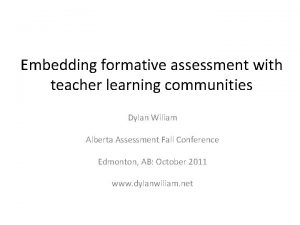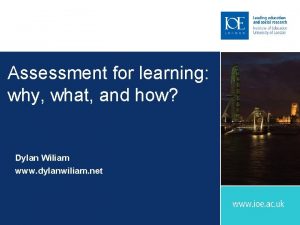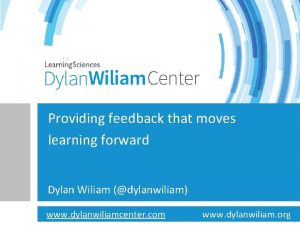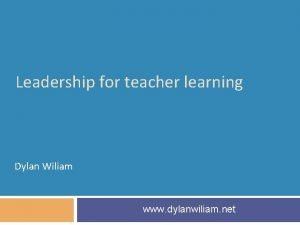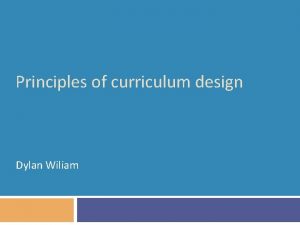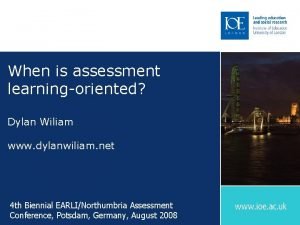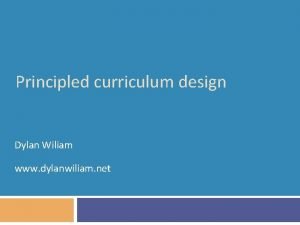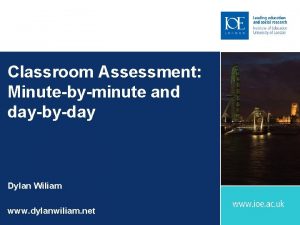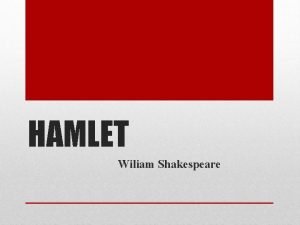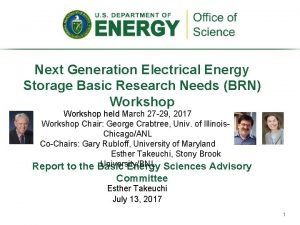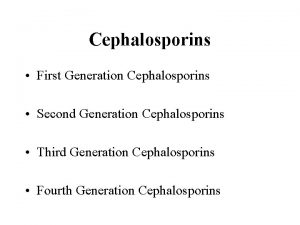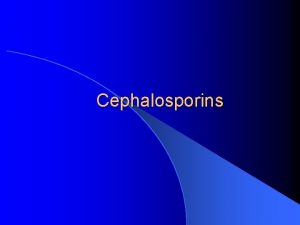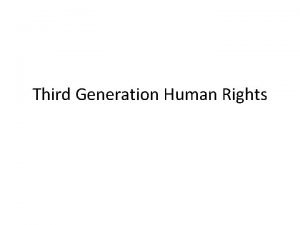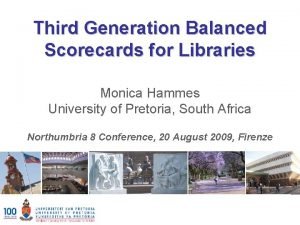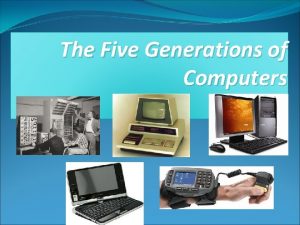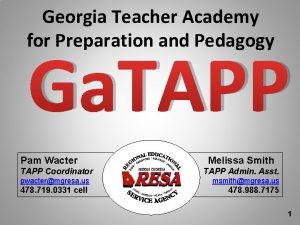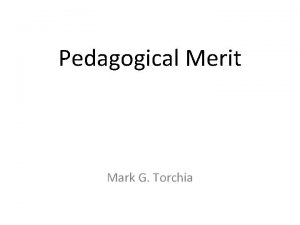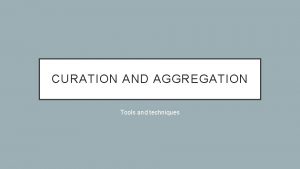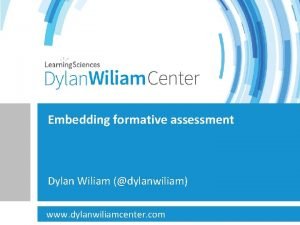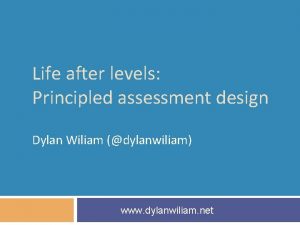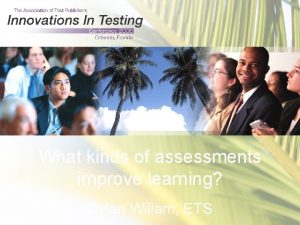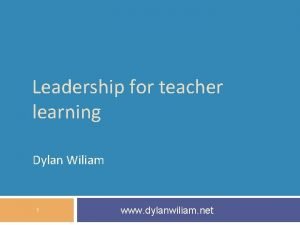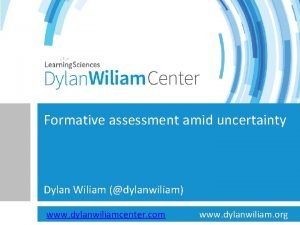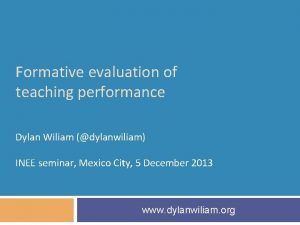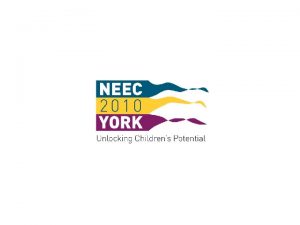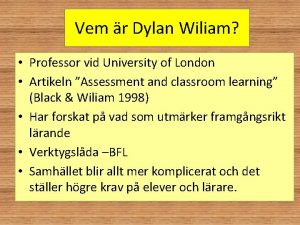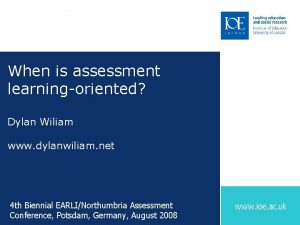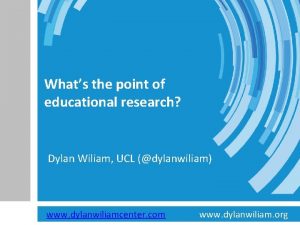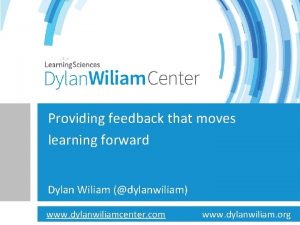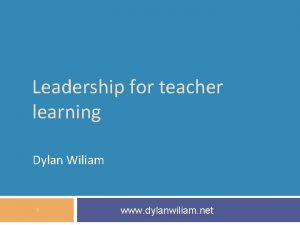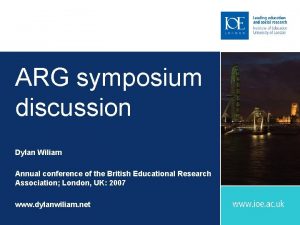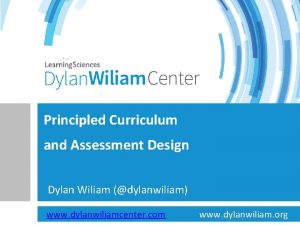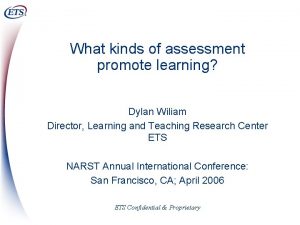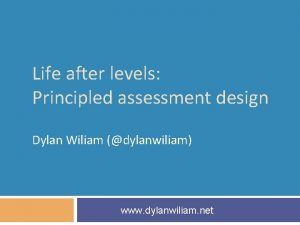Classroom aggregation technologies third generation pedagogy Dylan Wiliam
























- Slides: 24

Classroom aggregation technologies: third generation pedagogy Dylan Wiliam Institute of Education, University of London


What do we need students to learn? . . . the model that says ‘learn while you are at school the skills that you will apply during your lifetime’ is no longer tenable. These skills will be obsolete by the time you get into the workplace and need them, except for one skill – the skill of being able to learn. It is the skill of being able, not to give the right answer to questions about what you were taught in school, but to make the right response to situations that are outside the scope of what you were taught in school. We need to produce people who know how to act when they are faced with situations for which they were not specifically prepared. (Papert, 1998)

Preparation for future learning (PFL) Cannot be taught in isolation from other learning Students still need the basic skills of literacy, numeracy, concepts and facts Learning power is developed primarily through pedagogy, not curriculum We have to change the way teachers teach, not what they teach

Successful education The test of successful education is not the amount of knowledge that a pupil takes away from school, but his [sic] appetite to know and his capacity to learn. If the school sends out children with the desire for knowledge and some idea how to acquire it, it will have done its work. Too many leave school with the appetite killed and the mind loaded with undigested lumps of information. The good schoolmaster [sic] is known by the number of valuable subjects which he declines to teach. (Sir Richard Livingstone, President of Corpus Christi College, Oxford, 1941)

Learning power environments Key concept: Teachers do not create learning Learners create learning Teaching as engineering learning environments Key features: Create student engagement (pedagogies of engagement) Well-regulated (pedagogies of contingency)

Why pedagogies of engagement? Intelligence is partly inherited So what? Intelligence is partly environmental Environment creates intelligence Intelligence creates environment Learning environments High cognitive demand Inclusive Obligatory

Motivation: cause or effect? high arousal Flow anxiety challenge control worry apathy low relaxation boredom competence high (Csikszentmihalyi, 1990)

Why pedagogies of contingency? For evaluating institutions For describing individuals For supporting learning Monitoring learning Whether learning is taking place Diagnosing (informing) learning What is not being learnt Forming learning What to do about it

Effects of formative assessment Several major reviews of the research Natriello (1987) Crooks (1988) Kluger & De. Nisi (1996) Black & Wiliam (1998) Nyquist (2003) All find consistent, substantial effects

Cost/effect comparisons Intervention Extra learning Cost/yr/ classroom Class-size reduction (by 30%) 20% £ 20 k Increase teacher content knowledge by 1 sd 5% ? Formative assessment/ Assessment for learning 75% £ 2 k

Three generations of pedagogy First generation Traditional pedagogy Second generation All student response systems Third generation Automated aggregation technologies

Five-process architecture Task selection Task presentation Evidence elicitation Evidence identification Evidence accumulation After Almond, Steinberg and Mislevy (2002)

Evidence elicitation Single student response systems All-student response systems Flash-cards/dry erase boards Classroom ‘clickers’ Traditional keyboards (wired/wireless) Anoto pens

Anoto pen Wireless pen Special coated paper Pen ‘knows where it is’

Palm with wireless keyboard Text-based input Limited task-presentation capability Portable

Classroom ‘clickers’

Questioning in science: diagnosis The ball sitting on the table is not moving. It is not moving because: A. no forces are pushing or pulling on the ball. B. gravity is pulling down, but the table is in the way. C. the table pushes up with the same force that gravity pulls down D. gravity is holding it onto the table. E. there is a force inside the ball keeping it from rolling off the table Wilson & Draney, 2004

Questioning in math: diagnosis In which of these right triangles is a 2 + b 2 = c 2 ? A b a B a c C b a b D c c b c E c a a b F b c a

Discourse® www. ets. org/discourse

Evidence capture Automated essay scoring (e-rater) Paraphrase analysers (c-rater) Graphical analysers (m-rater)

All-student response systems clickers c-rater aggregation automated teachermediated latent semantic analysis ABCD cards dry-erase boards structured Discourse® unstructured evidence structure

Evidence accumulation Unidimensional student models Bayesian inference networks Proficiency model Task model Evidence model Student model

Evidence utilization Whole-class Sub-groups Homogenous Heterogenous Individualization
 Dylan wiliam teacher learning communities
Dylan wiliam teacher learning communities Dylan wiliam formative assessment
Dylan wiliam formative assessment Feedback dylan wiliam
Feedback dylan wiliam Tlc dylan wiliam
Tlc dylan wiliam Dylan williams skills
Dylan williams skills Dylan wiliam learning intentions
Dylan wiliam learning intentions Principled curriculum design
Principled curriculum design Tlc dylan wiliam
Tlc dylan wiliam Temeljni dramski sukob hamlet
Temeljni dramski sukob hamlet Electrical energy
Electrical energy First gen antipsychotics
First gen antipsychotics We worship you hallelujah
We worship you hallelujah Pharmoco
Pharmoco First generation cephalosporin
First generation cephalosporin Size of second generation computer
Size of second generation computer What does 1st generation mean
What does 1st generation mean First generation human rights
First generation human rights Third generation balanced scorecard
Third generation balanced scorecard Third-generation cephalosporin
Third-generation cephalosporin What are the five generations of computers
What are the five generations of computers Gj mount classification of dental caries
Gj mount classification of dental caries Caries on lingual surfaces of maxillary incisors
Caries on lingual surfaces of maxillary incisors Btech smart classes
Btech smart classes Georgia teacher academy for preparation and pedagogy
Georgia teacher academy for preparation and pedagogy How to pronounce pedagogical
How to pronounce pedagogical
